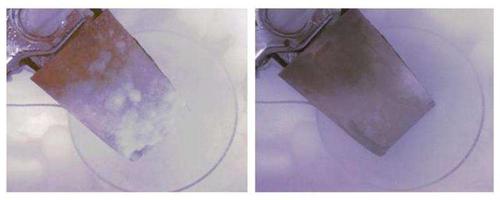Researchers at Rice University have developed a composite coating they say could keep airplane wings free of ice. So far, it's made the ice on a helicopter blade melt, even at -4F. Better yet, the graphene it contains in tiny amounts isn't insanely expensive to produce.
February 29, 2016
Making graphene in big sheets can cost a lot. Scientists at Rice University's Tour Group Lab should know: they invented the process for commercially producing thin, highly conductive graphene nanoribbons by unzipping nanotubes. They also discovered years ago that in composites, those nanoribbons would interconnect and conduct electricity across the composite material with much lower loadings than are usually needed. In previous experiments, the nanoribbons in films de-iced radar domes and glass.

Rice University lab tests demonstrate that a thin coating of epoxy infused with graphene nanoribbons can keep aircraft wings, wind turbine blades, and transmission lines free of ice. When a small voltage was applied to the coating on a helicopter rotor blade section chilled to -4F, the centimer-thick ice buildup melted right off.
(Source: Tour Group Lab, Rice University)
That means a much smaller proportion of graphene is needed and it can be activated with low voltages. The thin composite coating the scientists developed contains at most 5% graphene, consisting of nanoribbons on average 30 nm thick, in an epoxy matrix.
Led by Rice graduate student Abdul-Rahman Raji, lab researchers first removed the thermally conductive nickel abrasion sleeve on the leading edge of a stationary helicopter rotor blade segment. They spread a thin coat of the composite coating on the blade, and then replaced the sleeve. Lab tests were conducted in -4F temperatures (-20C), where ice about 1 cm thick formed on the blade. A small voltage with a power density of 0.5W per square centimeter was applied to the coating, delivering electrothermal heat to the surface and melting the ice. The composite remained robust in temperatures up to nearly 600F.
READ MORE ARTICLES ON GRAPHENE AND COMPOSITES:
For blades or wings in motion, Tour Group lab head James Tour said the thin layer of water that initially forms between the blade's surface and the heated composite should be enough to loosen the ice so it falls off, without having to be completely melted. The coating could be an effective, real-time de-icer for aircraft, wind turbines, transmission lines, and other surfaces exposed to winter weather, as well as more environmentally friendly than the glycol-based chemicals currently used at airports. Tour said it could also help protect aircraft from lightning strikes and provide an extra layer of electromagnetic shielding.
The team described its research in an article in the journal ACS Applied Materials and Interfaces. In addition to Raji, co-authors are Rice undergraduates Tanvi Varadhachary and Kewang Nan, graduate student Tuo Wang, postdoctoral researchers Jian Lin and Yongsung Ji, and research scientist Carter Kittrell, as well as alumni Yu Zhu of the University of Akron and Bostjan Genorio of the University of Ljubljana, Slovenia. The research was supported by the Air Force Office of Scientific Research and Carson Helicopter.
Ann R. Thryft is senior technical editor, materials & assembly, for Design News. She's been writing about manufacturing- and electronics-related technologies for 28 years, covering manufacturing materials & processes, alternative energy, and robotics. In the past, she's also written about machine vision and all kinds of communications.

About the Author(s)
You May Also Like



